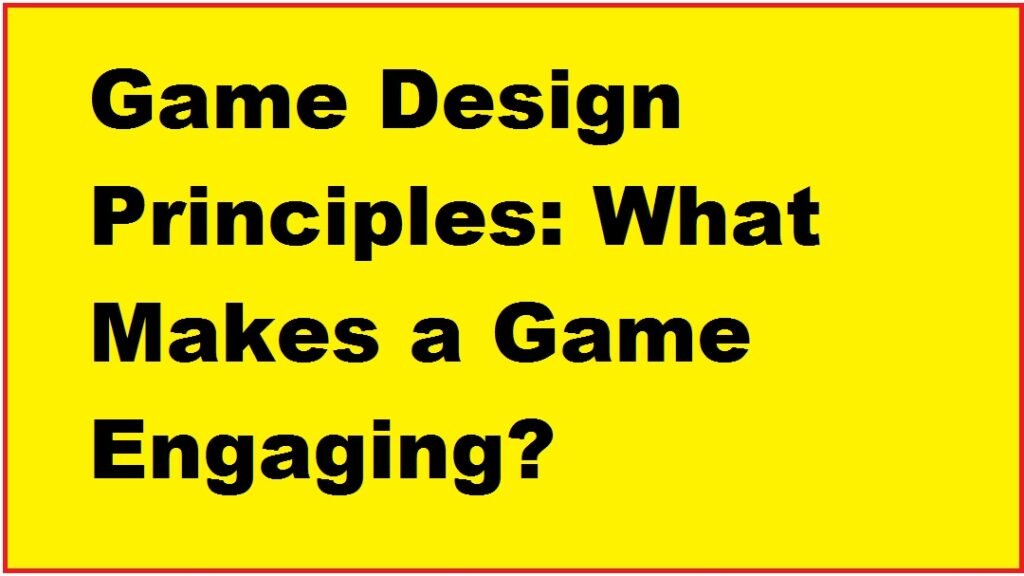Game Design Principles: What Makes a Game Engaging?

The world of games offers a captivating escape, a thrilling challenge, and a chance to connect with others. But what makes a game truly engaging? What keeps us glued to our screens, controllers in hand, late into the night? The answer lies in the art and science of game design, a field that blends creativity with structured principles to craft immersive experiences.
In this article, we’ll delve into the fundamental game design principles that contribute to a game’s captivating nature. By understanding these principles, aspiring game developers and enthusiasts can unlock the secrets behind truly engaging gameplay.
Planting the Seeds of Engagement: Clear Objectives and Goals
Imagine stepping into a game with no idea what to do. It wouldn’t be very fun, would it? That’s why setting clear objectives and goals is paramount. These objectives provide players with a sense of direction and purpose. They could be simple, like completing a level, or more complex, like unraveling a grand mystery. Regardless of the scale, clear objectives create a roadmap for players, giving them a sense of accomplishment as they progress.
Weaving a Captivating Tapestry: Compelling Storytelling
A well-crafted story can elevate a game from mere entertainment to an unforgettable experience. Games that weave compelling narratives with intriguing characters and plot twists can hook players and keep them invested in the game world. Imagine a game where you’re not just fighting monsters, but uncovering the secrets of a cursed kingdom – the stakes suddenly feel much higher. Effective storytelling fosters emotional connections, making players care about the characters and the world they inhabit.
Finding the Sweet Spot: Balanced Challenge and Skill
The ideal gameplay loop thrives on a delicate balance between challenge and skill. Games that are too easy become monotonous, while those that are brutally difficult can lead to frustration and abandonment. The sweet spot lies in providing enough challenge to keep players engaged and motivated to improve, without feeling overwhelmed or defeated. Difficulty should offer a gradual progression, allowing players to develop their skills and master the game’s mechanics over time.
Making Every Action Count: Interactive and Responsive Gameplay
Games are interactive playgrounds. Players crave a sense of agency, the feeling that their actions have a meaningful impact on the game world. Responsive gameplay mechanics are crucial in achieving this. This can involve dynamic environments that react to player choices, NPC interactions that feel natural and engaging, and immediate feedback on player actions. By reacting to players’ decisions, the game world comes alive, fostering a deeper level of immersion.
Reaping the Rewards: Reward Systems and Progression
Let’s face it, a little pat on the back (or in-game equivalent) goes a long way. Reward systems and progression mechanics are powerful tools for keeping players engaged over the long haul. These rewards can come in various forms, like unlocking new abilities, acquiring in-game currency, or accessing exclusive content. They provide a sense of accomplishment and motivate players to keep exploring the game’s features. Effective reward systems should feel meaningful, not too frequent or too rare, striking a balance that keeps players hooked without feeling like they’re constantly chasing the next reward.
A Feast for the Senses: Immersive Audiovisual Elements
High-quality audio and visual elements are the brushstrokes that paint a truly immersive gaming experience. Stunning graphics that bring the game world to life, realistic sound effects that create a sense of presence, and an evocative soundtrack that sets the mood are all crucial for captivating players. Imagine exploring a lush forest with crisp visuals, the sounds of birds chirping and leaves rustling in the wind – it becomes more than just a game, it becomes a place you can get lost in.
Giving Players the Reins: Player Agency and Choice
Empowering players with agency and meaningful choices personalizes the gaming experience. Branching storylines, multiple endings, and player-driven decisions add a layer of depth and replayability. When players feel like their actions have consequences that shape the world around them, they become more invested in the game’s outcome. This sense of control and autonomy fosters a deeper connection with the game and its characters.
Building a Community: Social Interaction and Community
The rise of online gaming has opened doors for social interaction and community building. Multiplayer modes, leaderboards, in-game chat features, and collaborative gameplay allow players to connect with each other, fostering a sense of camaraderie and friendly competition. This social aspect can extend beyond the game itself, with players forming online communities where they can discuss strategies, share experiences, and build lasting friendships.
The Final Score: Crafting Games that Endure
Effective game design is a symphony of these principles working in harmony. By focusing on clear objectives, captivating storytelling, balanced gameplay, rewarding progression, immersive audiovisuals, player agency, and social interaction, game developers can create games that resonate with players and stand the test of time. Understanding what makes a game engaging is not just about success in the gaming industry;It’s about crafting experiences that leave a lasting impression on players worldwide.
Beyond the Basics: Advanced Engagement Strategies
While these core principles form a solid foundation, the world of game design is constantly evolving. Here are some additional strategies that developers can leverage to further enhance player engagement:
- Mastery and Flow: Games can be designed to encourage players to enter a state of “flow,” a state of complete absorption in the activity at hand. This can be achieved through well-designed mechanics that provide a clear learning curve, allowing players to gradually master the skills needed to progress. The sense of accomplishment from overcoming challenges and improving skills fuels engagement and keeps players coming back for more.
- Variety and Surprise: While maintaining a core gameplay loop is important, introducing elements of surprise and variety can keep players engaged over longer sessions. This can involve introducing new challenges, hidden secrets, or unexpected events that keep players guessing and coming back for more. A well-placed surprise boss fight or a sudden plot twist can reignite excitement and keep players invested in the game world.
- Emotional Response: Evoking emotions in players can create a powerful connection to the game. Games can employ humor, suspense, fear, or even sadness to create a more impactful experience. A game that makes you laugh out loud or one that keeps you on the edge of your seat is far more memorable than one that evokes no emotions whatsoever.
- Learning and Growth: Many games incorporate mechanics that allow players to learn and grow their skills over time. This can be through character development, unlocking new abilities, or even educational elements embedded within the gameplay. Players are intrinsically motivated to learn and improve, and games that tap into this desire can foster a deeper sense of engagement.
- Accessibility and Inclusivity: Catering to a wider audience goes beyond just demographics. Designing games that are accessible to players with different abilities allows for a more inclusive and engaging experience for everyone. This can involve features like adjustable difficulty settings, colorblind modes, and controller remapping options.
The Art of Iteration: Playtesting and Feedback
No matter how well-crafted a game’s design principles may seem, the true test lies in how players experience it. Playtesting throughout the development process is crucial. By observing players interact with the game, developers can identify areas for improvement, gauge player engagement, and ensure the game mechanics are functioning as intended. Usability testing allows for early detection of frustrating mechanics or confusing interfaces, while observing player behavior can reveal unexpected uses of mechanics or areas where the game isn’t meeting player expectations.
Feedback from players, both during testing and after release, is invaluable in refining the game and keeping it engaging for a wider audience. Open communication channels with players allow developers to understand what’s working and what’s not, and to make adjustments that can significantly improve the overall player experience.
Game design is a vast and ever-evolving field. By understanding the core principles that contribute to player engagement and staying informed about the latest trends, aspiring game designers can embark on a rewarding journey of crafting captivating experiences. This journey involves not just mastering the technical aspects of game development, but also fostering creativity, empathy, and a passion for creating worlds that players can lose themselves in. So, whether you’re a seasoned developer or just starting out, remember, the most engaging games are those that tap into the universal human desire for challenge, connection, and a truly immersive escape.
- Innovative Game Design Techniques: Elevating User Experience to New Heights
 Innovative Game Design Techniques: In the ever-evolving realm of gaming, innovation reigns supreme. It’s the lifeblood that breathes excitement and keeps players glued to their screens. From captivating narratives that tug at our heartstrings to immersive gameplay that pushes the boundaries of reality, every element contributes to crafting unforgettable gaming experiences. Today, we delve into
Innovative Game Design Techniques: In the ever-evolving realm of gaming, innovation reigns supreme. It’s the lifeblood that breathes excitement and keeps players glued to their screens. From captivating narratives that tug at our heartstrings to immersive gameplay that pushes the boundaries of reality, every element contributes to crafting unforgettable gaming experiences. Today, we delve into - Latest Twitch Updates for Top Games: A Comprehensive Guide
 Latest Twitch Updates for Top Games: Twitch, the undisputed king of live streaming platforms for gamers, is constantly innovating to cater to its massive and ever-evolving user base. Regular updates and feature rollouts are a defining aspect of Twitch. Whether you’re a seasoned streamer captivating audiences or a viewer seeking the latest entertainment, staying updated
Latest Twitch Updates for Top Games: Twitch, the undisputed king of live streaming platforms for gamers, is constantly innovating to cater to its massive and ever-evolving user base. Regular updates and feature rollouts are a defining aspect of Twitch. Whether you’re a seasoned streamer captivating audiences or a viewer seeking the latest entertainment, staying updated - The Future of Gaming: Exploring VR Technology in Multiplayer Gaming
 Exploring VR Technology in Multiplayer Gaming : Virtual Reality (VR) technology has shattered the limitations of traditional gaming, ushering in an era of unparalleled immersion that transcends the confines of a screen. With the integration of multiplayer capabilities, VR has further revolutionized the gaming landscape, fostering a new realm of social interaction, collaboration, and competition
Exploring VR Technology in Multiplayer Gaming : Virtual Reality (VR) technology has shattered the limitations of traditional gaming, ushering in an era of unparalleled immersion that transcends the confines of a screen. With the integration of multiplayer capabilities, VR has further revolutionized the gaming landscape, fostering a new realm of social interaction, collaboration, and competition - Biggest Gaming Industry Acquisitions: A Power Play for the Future
 Biggest Gaming Industry Acquisitions: The gaming industry is a behemoth, constantly evolving and pushing the boundaries of entertainment. Mergers and acquisitions (M&A) have become a cornerstone of this growth, shaping the landscape and fueling innovation. This article dives into the biggest gaming industry acquisitions, their impact, and future trends that will redefine the way we
Biggest Gaming Industry Acquisitions: The gaming industry is a behemoth, constantly evolving and pushing the boundaries of entertainment. Mergers and acquisitions (M&A) have become a cornerstone of this growth, shaping the landscape and fueling innovation. This article dives into the biggest gaming industry acquisitions, their impact, and future trends that will redefine the way we - Insights from Top Game Developers: Strategies for Success in a Dynamic Industry
 Insights from Top Game Developers: The gaming industry is a thrilling rollercoaster ride. Trends shift, technologies leap forward, and new competitors emerge at breakneck speed. In this ever-evolving environment, top game developers stand out as masters of innovation, strategy, and adaptation. Their insights hold immense value for aspiring developers and industry enthusiasts alike, offering a
Insights from Top Game Developers: The gaming industry is a thrilling rollercoaster ride. Trends shift, technologies leap forward, and new competitors emerge at breakneck speed. In this ever-evolving environment, top game developers stand out as masters of innovation, strategy, and adaptation. Their insights hold immense value for aspiring developers and industry enthusiasts alike, offering a

